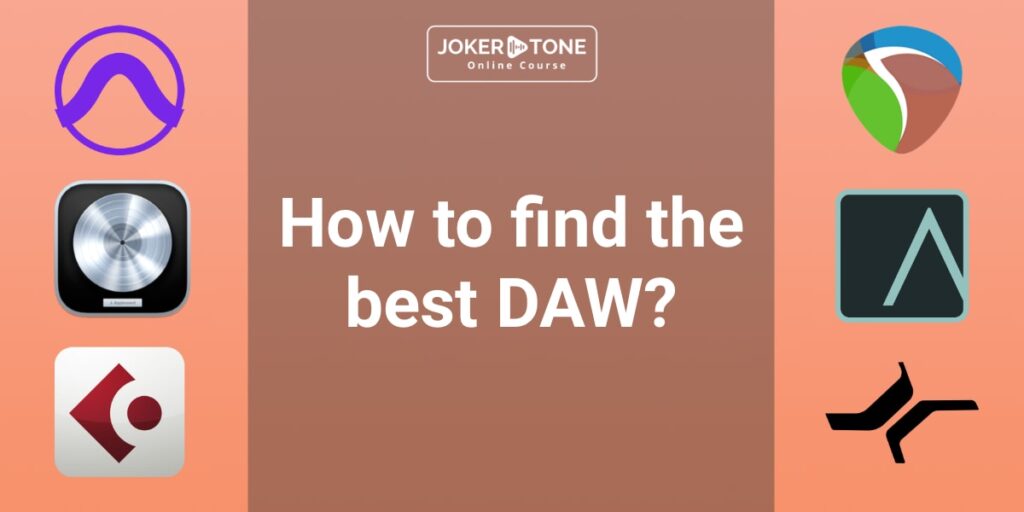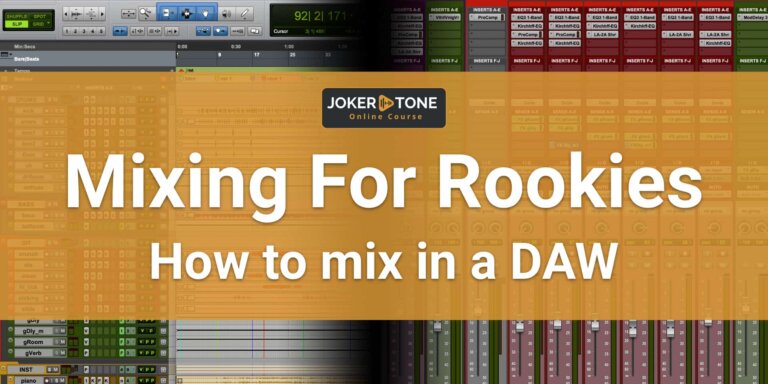In this blog post, I explain my five essential factors for choosing the right software for music production and show you an example of how I found the best DAW for home recording for myself. By the end of this post, you’ll have all the information you need to make your way through the multitude of digital audio workstations without getting lost in countless comparisons. You can then make an informed decision as to which digital audio workstations you should test extensively. In this way, you will quickly find a suitable DAW that is tailored to your requirements.
Overview of the content on how to find the best DAW for home recording:
The five essential factors to find the best DAW for home recording, plus a bonus factor:
- What do I need, what are my requirements
- The visual feedback on the screen
- What’s on board with the most popular DAWs
- The test option and subsequent costs
- The right interface for the DAW
- “Optional” — the right DAW controller
There are numerous DAWs (digital audio workstations) on the market, to name just a few: Pro Tools, Logic Pro and Garage Band, Cubase and Nuendo, Ableton Live, Bitwig, Reaper, Harrison Mixbus, Digital Performer, Reason, Studio One, UAD Luna, Mackie Traction, FL Studio, Mixcraft…and probably some more.
Some may be free, but some may be very stripped down, some you can purchase a perpetual license for, and others are available in both subscription and subscription models.
Most DAWs offer similar features in the basic package, possibly in different ways, but some have developed into complex DAWs from specific directions.
For example, Apple’s Logic X Pro is known for its good and extensive MIDI function and is very suitable for composing and arranging, while Avid Pro Tools stands for convenient editing and in-depth mixing.
How do you find your way through all these options and variants to find the best DAW for home recording?
I want to give you a solution for how you can work through the whole DAW offer to find the best suitable and working DAW for your recording and song production.
Five essential factors + one bonus option
1) What do I need and what are my requirements when I look for software for music production?
You should ask yourself at first what you require now and maybe what could be your requirements within the next 1 or 2 years.
- What are the main tasks for your DAW for the kind of music production you want to do (audio recording, electronic with samples, intensive MIDI editing, virtual instruments)
- Are you depending on the operating system/computer, like a Mac or PC (e.g., Universal Audio Luna can only be used on Mac at the time this blog post was written)
- Are you depending on a specific interface that you already have or want to use (e.g., Direct DSP Monitoring function of Universal Audio Luna or Avid Pro Tools can only be used properly with their related interfaces like UA Apollo or Avid HD/Carbon)
2) Visual Feedback & Workflows
You will watch long times on the visual interface. For the best DAW for home recording, this should be easy to read and at best fits your needs at 80% from the start without changing anything. If you can change the layout, GUI, and colors on your own or with some 3rd party skins, it is another bonus. These kinds of options bring the DAW with an excellent workflow and a mediocre GUI to the TOP of choice for you.
- Do I like the look of the mixing and editing visual interface?
- Are there possibilities to customize the GUI if necessary
- Do you like the structure of the DAW (mixer, playlist)
- Overview of the function (Reaper was a horror for me)
- Use of the functions (editing, automatization, recording style, key shortcuts configuration)
- How is the preference section built so that you can set and use the functions in a way that makes sense to your workflow
My personal experiences with the GUI:
- I used to use Pro Tools since 2007, and I have always been fine with the grey skin of the GUI. When they introduced the black skin, I never got to like that and was pretty happy that I still could use the old grey GUI and get more customized options (while I use just 5% of those options)
- Years ago I tried Reaper for some days and I didn’t get along with the GUI and the workflow. While I knew I could change the skin and that Reaper is one of the most powerful, flexible, user-friendly DAWs with maybe the best price point. And because all the hassles didn’t feel right to me, I checked another DAW while I searched for other options than pro tools.
- As a second DAW, I was keen to learn LUNA from Universal Audio. Right at the beginning, I bought the pro tools skin from someone who is not related to Universal Audio. But I never installed it because the LUNA skin already works for me, except with the choice of track and clip colors that you can’t change even with a third-party skin.
3) What is on board
The DAWs that have been on the market for a long time have been upgraded to such an extent that each of these applications already has 95% of what you need on board. This applies to plugins as well as functions for songwriting, arranging, editing, and mixing.
All well-known and popular DAWs are already on board:
- plugins that are usually good enough to create a perfect mix
- samples to use for your production
- Editing tools like pitch correction and time stretching
You have to decide what is important to you, whether what is included is enough, and which plugins you may need to buy to supplement the entire package or improve the workflow.
These can be special plugins like Melodyne (Pitch and Time correction). How is the integration, or does the DAW already have its pitch editing function on board, which is already completely sufficient for the projects?
I, for example, work only sometimes with virtual instruments and even less with pre-made samples. When these are used inside my creation, I have two large and powerful libraries at my disposal: Native Instrument and Toontrack. If DAWs are advertised with large sample packs, then this is completely uninteresting to me. Don’t get hyped about things you don’t need or don’t know if you need them.
4) Test and cost options
“Test it before binds yourself eternally” is a German saying and this is good advice before you invest in a system of DAW or even into an ecosystem like AVID or Universal Audio.
- Can you get your hand on a free or trial version for proper testing upfront?
- Is there a lite version available that would fit your needs?
- Can you upgrade later to a higher level when you require it?
- Can you buy a preputial license or are there other ways, like a subscription?
This could be a whole blog post on its own about this topic, but while I don’t know your current budget situation, I won’t speculate what kind of pricing option you prefer. I don’t think a subscription is a bad thing at all, but I prefer to know that I can use the main software even though I am not paying any more for updates or support.
When I started, AVID (former Digidesign) had a preputial license and when a bigger upgrade was in the door you could buy an upgrade. Then AVID came up with a subscription and tried to get the customer into that while offering a preputial license with a paid “yearly support plan”. Now they are nearly back to the old system while still having the option of subscription, which is fine because everybody can choose the price option that fits their need.
Logic Pro X from Apple is the complete difference. Buy it once for a low price point in my view for what you get and use it for many years with free updates and upgrades.
Keep in mind: The best price or biggest packing of software items won’t help you if you don’t like to use the DAW.
5) Matching interface (ecosystem)
Before you decide on a DAW you can look at what kind of interface is the best working partner to get the most out of a stable system. Going into an ecosystem can have some advantages:
- Tuned to the DAW by the manufacturer itself will give you a better user experience and maybe some additional helpful functions
- The chance to get better support when you are inside the ecosystem is higher
- Probably faster troubleshooting within the ecosystem because the support can check and track down the issues better when only their hard- and software are used (of course on a support computer system)
I worked on a Pro Tools HD Systems, had a Pro Tools Carbon system at my place, for a very short time a Motu System (with also trying their DAW Digital Performer), and at this time a Universal Audio Apollo System (again the second time, also with in mind to get into their junger DAW Luna).
While Pro Tools is my main DAW I never worked on an easier and more stable interface than the Apollo line — but that is only my experience. You will find thousands of meanings and views on different ecosystems. If you can, see if one fits all your needs and budget, and then try one out.
Remember that changing from an ecosystem could be a hard and pricy way to walk.
BONUS) Matching Controller
To control your DAW with a matching controller is not only attractive, it makes it more fun and can cut down the production time. For me, having faders, buttons, and knobs to use against only keys and a mouse is another world of production, especially in the mixing stages.
Some production companies have their controller and their controller protocol (Like AVID with their Eucon Controllers) and other companies have produced very well-laid-out controls that can match many DAWs (like Solid State Logic or Mackie).
In the end, you have to find out again what you require and want to do. The Eucon protocol is, in my view, very difficult to beat when it comes to a very deep integration to a daw that supports Eucon and at best inside the AVID ecosystem with Interface, Software, and Controller. But it is also very pricey and maybe not the best fit for you.
I came from a Pro Tools Carbon Interface, with Pro Tools as DAW and their Artist Controller Series. When they changed to the S1 Controller I looked for another system while I also changed the interface and was happy with a Universal Audio Apollo Interface, the SSL UF8 Controller and still using Pro Tools as my main DAW. I don’t miss the Eucon days because my system does exactly what I need and want to do with it. I am fine with a less deep integration like with Eucon. Of course…“the wish for better” is never-ending.
Conclusion
You won’t come around without testing some (more) DAWs by yourself to find the one that works for you, but you can narrow down the selection if you know what you need to produce your music.
Watching tutorials can also be very helpful here, but try to limit it because you can also waste a lot of valuable time here
You will find many and probably more bad user experiences inside some communities about some “massive problems”, “this doesn’t work right”, or “Is this a bug?”
No app or specific DAW is 100% bug-free or will be perfect for anybody. But not less often the “problems” are related to other factors like the used computer, a third-party problem, or the user itself. Because he or she doesn’t take the time to look upfront, at least at all these points inside this post, nor do they take the manpower to check what is related to the issue on their side. It is just still easier to write a short line inside a community. So don’t get scared when you look for your best-fit DAW.
Do you want to know how you can narrow down the selection so as not to test 10+ DAWs?
If you are not already on, get on the Joker Tone Course mailing list, and you will receive this and other helpful guidance from me.
Do you like watching a video clip to this topic? Here you can find one of my video clips about how to find the best DAW for home recording
If you have further questions or want to get in contact, please use the contact form
Niels from Joker Tone Course




